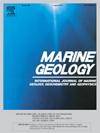Sedimentation of tidal sand ridges off the Liuguhe River mouth in the Liaodong Bay, Bohai Sea
IF 2.6
3区 地球科学
Q2 GEOSCIENCES, MULTIDISCIPLINARY
引用次数: 0
Abstract
The Liuguhe River mouth sand ridges in the Liaodong Bay, Bohai Sea, provide a good example for further understanding the sedimentation of small-scale tidal sand ridges. However, little is known about their morphological and sedimentary characteristics. This paper presents a comprehensive study of these sand ridges using survey data from sub-bottom profiling, side-scan sonar mapping, and acoustic doppler current profiling, along with piston core analyses of grain-size and heavy minerals. The sand ridges span widths of 1–2.5 km and heights of 4–16 m, with diminishing heights toward the sea. Their cross-sections are asymmetrical, featuring gentler and steeper slope angles of less than 1.5° and up to 4.5°, respectively. Sand waves are widely superimposed on the sand ridges, exhibiting wavelengths of 0.7–62.3 m and heights of 0.11–3.12 m. The ridge sediment consists of well sorted medium sand, while the trough sediment consists of very poorly sorted silty sand, indicating that the ridges are coarser and better sorted than the troughs. The tidal deposits are characterized by high levels of magnetite and hematite. Provenance discrimination based on heavy mineral assemblages indicates that the sediment is mainly derived from the Liuguhe River. The sand ridges have been formed since the middle Holocene and are still active at present. The tidal currents are rectilinear. Near-bed currents exceeding the critical velocity of sediment motion account for 20 % of a tidal cycle, implying that the tidal currents are capable of maintaining the development of bedforms. The longitudinal axes of the sand ridges exhibit anticlockwise rotation relative to the direction of the maximum tidal current, with an angle of up to 30°. The steeper slopes of the sand waves on both flanks of the sand ridges point to ridge crestlines, implying a tendency for sand streams to converge on the ridge crestlines. The sand ridges and adjacent troughs consist entirely of modern tidal deposits in the shoreward area, while the troughs are incised in the underlying strata with a thin layer of modern tidal deposits covering on the surface in the seaward area. Seaward decrease in sediment supplies may explain the seaward changes in ridge structures and heights.
辽东湾六家河河口潮沙脊的沉积
辽东湾柳家河河口沙脊为进一步认识小规模潮沙脊的沉积作用提供了很好的范例。然而,对其形态和沉积特征了解甚少。本文对这些砂脊进行了全面的研究,使用了海底剖面、侧扫声纳测绘和声学多普勒电流剖面的测量数据,以及活塞岩心粒度和重矿物的分析。沙脊宽度为1 ~ 2.5 km,高度为4 ~ 16 m,向海高度逐渐减小。它们的横截面是不对称的,具有较平缓和较陡的坡度,分别小于1.5°和高达4.5°。沙浪广泛叠加在沙脊上,波长0.7 ~ 62.3 m,高度0.11 ~ 3.12 m。脊状沉积物由分选良好的中砂组成,而槽状沉积物由分选很差的粉砂组成,表明脊状沉积物比槽状沉积物粗,分选好。潮汐矿床的特点是磁铁矿和赤铁矿含量高。基于重矿物组合的物源判别表明,沉积物主要来源于柳家河。砂脊形成于全新世中期,至今仍处于活跃状态。潮流是直线的。超过泥沙运动临界速度的近床流占一个潮汐循环的20%,表明潮流能够维持河床的发育。沙脊的纵轴相对于最大潮流方向呈逆时针旋转,转角可达30°。沙脊两侧沙波的陡坡指向沙脊脊线,表明沙流有向沙脊线汇聚的趋势。滨岸区砂脊和相邻的海槽完全由现代潮汐沉积组成,而海槽则在下伏地层中切割而成,临海区表层覆盖一层薄薄的现代潮汐沉积。向海沉积物供应的减少可以解释山脊结构和高度的向海变化。
本文章由计算机程序翻译,如有差异,请以英文原文为准。
求助全文
约1分钟内获得全文
求助全文
来源期刊

Marine Geology
地学-地球科学综合
CiteScore
6.10
自引率
6.90%
发文量
175
审稿时长
21.9 weeks
期刊介绍:
Marine Geology is the premier international journal on marine geological processes in the broadest sense. We seek papers that are comprehensive, interdisciplinary and synthetic that will be lasting contributions to the field. Although most papers are based on regional studies, they must demonstrate new findings of international significance. We accept papers on subjects as diverse as seafloor hydrothermal systems, beach dynamics, early diagenesis, microbiological studies in sediments, palaeoclimate studies and geophysical studies of the seabed. We encourage papers that address emerging new fields, for example the influence of anthropogenic processes on coastal/marine geology and coastal/marine geoarchaeology. We insist that the papers are concerned with the marine realm and that they deal with geology: with rocks, sediments, and physical and chemical processes affecting them. Papers should address scientific hypotheses: highly descriptive data compilations or papers that deal only with marine management and risk assessment should be submitted to other journals. Papers on laboratory or modelling studies must demonstrate direct relevance to marine processes or deposits. The primary criteria for acceptance of papers is that the science is of high quality, novel, significant, and of broad international interest.
 求助内容:
求助内容: 应助结果提醒方式:
应助结果提醒方式:


